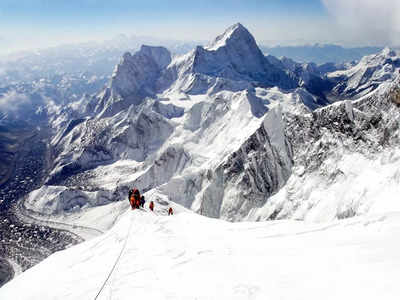By Tirthankar Mitra
Nepal has decided to hike the permit fees to climb Mount Everest. It will certainly boost Nepal’s revenues. Yet it raises the question about the ethics of commercialisation of scaling one of the world’s most revered natural wonders. Issues pertaining to sustainability and overcrowding come up in the wake of the decision of increasing the permit fees. It has been upped from $11,000 to $15,000 during peak season. For Nepal, the economic stakes are significant.
In all, 4 per cent of the national GDP is contributed from the permit fees of mountaineering and trekking. It is a crucial pillar of Nepalese economy. Infrastructure, local livelihood and development of remote regions of this Himalayan country are supported by revenue from climbing permits. One must not lose sight of the fact that the climbing fee has been hiked the first time in nearly a decade.
Everest faces mounting challenges. The increase in climbing permits fees must be paired with addressing them. A look at the scenario reveals that hundreds of climbing permits are issued every year. Needless to say overcrowding has become an alarming issue. Its fallout is Everest facing a high altitude traffic jam with the high influx of climbers. Dangerous bottlenecks develop at critical points on the mountain.
The situation affects lives during rescue operations for mountaineers cut off from oxygen and supplies. And one cannot overlook the environmental toll exacerbated by the mountaineers footfall. The famous mountain peak is often referred to as the world’s highest garbage dump. Owing to mismanagement it has earned such a title which is neither in keeping with its great height nor the pristine snow covering it.
The climbers leave behind tonnes of waste and even human remains. Despite periodic drives the cleanup task remains daunting. A steep climbing fees would deter less serious climbers. Thus it has a potential to reduce congestion. On the other hand, it is unlikely to curb aspirations of wealthy adventurers. Nor would it discourage commercial expedition companies.
A more comprehensive regulatory framework is needed. It would cap the number of permits issued every year. Nepal Supreme Court have recently ordered to respect the carrying capacity of the peaks of the country. It is indeed a step in the right direction but has ethical considerations too. The implementation of the top court order remains uncertain. Mountaineering has long been a feat of passion and endurance.
But the hike in climbing permit fees can turn it into a luxury experience only a few can afford. This exclusivity being biased in the favour of the elite undermine the spirit of exploration. One wonders whether Nepal’s iconic peak is being reduced to a mere commodity. The situation poses a dual challenge.
The sanctity of Everest has to be preserved. Its economic potential has to be maximised. A balance has to be struck. The hiked permit fees has to be looked upon as necessary to protect the mountain’s fragile eco system.
Countless mountaineers have risked their lives to climb Everest and stand on top of the world. Their legacy has to be honoured by ensuring climber safety. Revenue has to match responsibility. Surely Nepal can set an example of sustainable tourism after having made a start. (IPA Service)


 Campaign For Delhi Assembly Election Gets Bizarre With Poison In Yamuna, Toxins In Air
Campaign For Delhi Assembly Election Gets Bizarre With Poison In Yamuna, Toxins In Air 